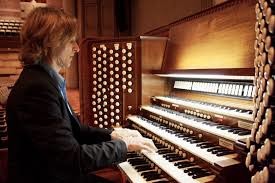 I sang baritone and sometimes tenor in the St. John’s Lutheran Church choir according the key of the hymn were rehearsing and also depending upon who showed up for rehearsal. There were no try-outs for our choir; willingness to sing on Sunday was the primary requirement for membership. One of our brethren, I recall, had a voice that sounded like a frog, but he always showed up for service.
I sang baritone and sometimes tenor in the St. John’s Lutheran Church choir according the key of the hymn were rehearsing and also depending upon who showed up for rehearsal. There were no try-outs for our choir; willingness to sing on Sunday was the primary requirement for membership. One of our brethren, I recall, had a voice that sounded like a frog, but he always showed up for service.
I was thirteen years old at the time, surrounded by persons for the most part twenty to fifty years my senior. This was my first gig, my first rehearsal with the choir. I had been encouraged to join to bolster the tenor section for Easter services. Loretta M., the glue that held our motley voices together was a supremely patient and optimistic organist and choir director, a woman in her fifties, who no doubt had coached many choirs before ours. Loretta was a talented musician, but more that she was an excellent teacher.
“Good evening everyone,” Loretta exclaimed enthusiastically at our Thursday rehearsal. “This Sunday’s Liturgy for Easter services is one I think most of us are familiar with, but can we have a quick review? I’ll go through it once and you listen. Then we’ll break down the parts.”
Loretta played and sang the Liturgy once through, and then turned to us. “This is such a beautiful piece of music, such a key part of the service. We sounded great last year, and I know we’ll do well this year.” Then she smiled and said, “You know this service is standing room only.”
This was inspiring, but also made me nervous, apparently visibly so, as Loretta glanced my way with a friendly “it’ll be okay” nod. “First the soprano’s,” she said and proceeded to walk through the liturgy in sections. I wasn’t thinking PDCA at the time, but clearly each of us was experimenting, supported by Loretta’s gentle, positive feedback. Measure by measure we practiced until we were comfortable. Then the measures and sections were strung together, sopranos first, then tenor, then baritones and basses.
“Okay!” Loretta declared about ninety minutes into our rehearsal. “We have all the parts. Now let’s put them together. Don’t worry if you make a mistake, just keep going and you’ll catch up.” Loretta’s pipe organ introduction commenced and, on her cue, we began to sing. As she predicted there were mistakes; missed entrances and wrong notes, and a general imbalance of voices. But we achieved our first target. As we finished the liturgy, we turned to each other in surprise. One of us remarked, “We didn’t sound that bad.”
“Indeed,” Loretta agreed, “a great beginning.” Then she put a question to us: “Which are the areas we need to work on?” I think she knew the answers before she asked the question, but her question created reflection by every one of us. At age 13, I wasn’t thinking “Hansei,” but Loretta’s question created that experience.
By 10:00 p.m., after nearly three hours of rehearsal we sounded musical. Our liturgy would play to a standing room only congregation, and every one of us had a sense of personal accomplishment and organizational harmony.
O.L.D.
P.S. So why this post? Because I’m headed tomorrow to Kata Summit in Ft. Lauderdale, Florida to officially release GBMP’s latest DVD, Improvement Kata, a collaborative effort of GBMP, W3 Group and Leanovator. (Check out www.shopgbmp.org for other titles in our Lean Training DVD catalog - from Kanban to CEDAC, Quick Changeover to Idea Systems.) Hope to see you at the summit.
And don't forget about my monthly FREE webinar - Tea Time with The Toast Dude. It's this afternoon! This month's topic: Tips for Engaging More Employees in your Lean Implementation. Starts today at 3:00 pm. Register here!

